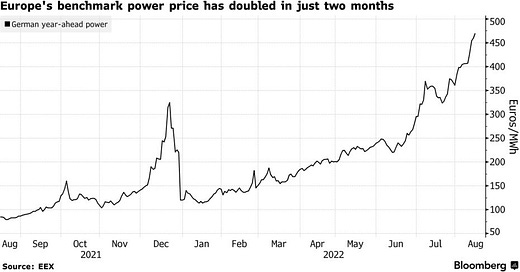Electricity prices across our continent have risen to horrifying new highs threatening the solvency of both households and corporations.
For example, the futures of December 2022 peak load price (essentially price at demand peak) have risen to inconceivable levels in France. Same applies to Finland and basically all countries in Europe (see, e.g, this and this).
These imply that:
Inflation in Europe will not come down, but is likely to accelerate notably during the winter/spring.
The ECB will be forced to hike rates, probably, in an expedited manner.
Household consumption and corporate investments are likely to crash in coming months.
There’s the possibility of blackouts throughout our continent in the winter.
The threat of a complete shutdown of German economy during the winter is also very real. German industries are heavily dependent on natural gas, and even with 100% storage capacity can cover just around a third of the needs of the German economy.
This essentially implies two things:
If Russia cuts off or considerably diminished gas supplies to Europe during the winter, German is, most likely, be forced shut down its economy (temporary closure of several industries) leading to a depression and to a mass unemployment.
Global natural gas prices are likely to increase further, possibly drastically, from the current, already notably elevated levels during the winter/spring.
The first one of these (high electricity prices, inflation, rate hikes) is enough to effectively guarantee the arrival of a deep recession in Europe before the end of the year. The second one (gas delivery disruptions), if materialized, would, most likely push our continent into an outright economic depression, and to a massive social unrest or even outright uprisings. We, thus, could be facing our darkest winter and spring since 1945.
In April, we wrote in our monthly Deprcon Outlook that:
…stock prices and consumer surveys point to a hefty drop in economic activity in the Eurozone, while business surveys also point to drop, while a bit more modest one. On the other hand both manufacturing and service purchasing managers’ indexes (PMIs) point to a robust expansion. Thus, the situation in the eurozone looks a bit similar as in the U.S., i.e., that while the current economic situation looks good, future prospects are considerably bleaker.
This is now materializing. The storm is approaching, fast, it will become global, and it can be something we have never seen before.
I present a more detailed analysis of the situation in Europe and its global ramifications in my monthly forecasts published later this month. You can find preperation guidelines from my previous posts.


